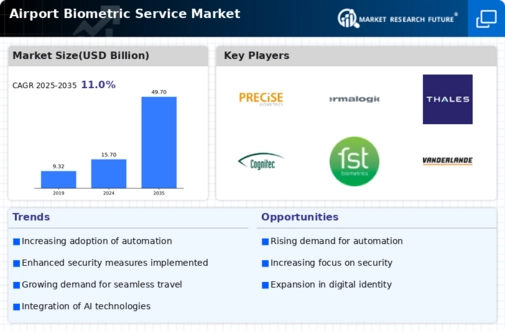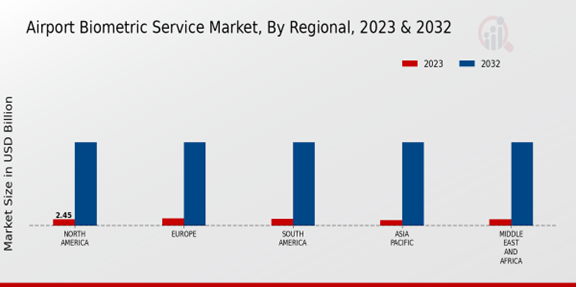Growing Global Air Travel
The Global Airport Biometric Service Market Industry is poised for growth due to the increasing volume of global air travel. As more individuals opt for air travel, airports face mounting pressure to enhance operational efficiency and passenger experience. Biometric solutions offer a viable approach to managing this influx, enabling faster processing times and reducing congestion. The International Air Transport Association projects that global air passenger numbers will reach 8.2 billion by 2037, highlighting the need for efficient airport operations. Consequently, the adoption of biometric technologies is likely to accelerate, contributing to the market's expansion.
Enhanced Security Measures
Security concerns remain a paramount driver in the Global Airport Biometric Service Market Industry. Biometric systems provide advanced security features that traditional methods cannot match. By utilizing unique biological traits, such as fingerprints or facial features, these systems significantly reduce the risk of identity fraud and unauthorized access. Airports adopting biometric technologies have reported a decrease in security breaches, thereby fostering passenger trust. The integration of these systems is likely to become more prevalent as global security standards evolve, further propelling market growth. The anticipated compound annual growth rate of 11.02% from 2025 to 2035 underscores this trend.
Government Initiatives and Regulations
Government initiatives play a crucial role in shaping the Global Airport Biometric Service Market Industry. Many countries are investing in biometric technologies to enhance border security and streamline immigration processes. For example, the implementation of biometric exit systems is mandated in several jurisdictions to monitor the movement of individuals across borders. These regulations not only promote the adoption of biometric solutions but also ensure compliance with international security standards. As governments continue to prioritize security and efficiency, the demand for biometric services in airports is expected to rise, contributing to the market's projected growth.
Technological Advancements in Biometric Systems
Technological advancements are a significant driver in the Global Airport Biometric Service Market Industry. Innovations in artificial intelligence and machine learning are enhancing the accuracy and efficiency of biometric systems. For instance, the integration of AI algorithms allows for real-time facial recognition, improving the speed of passenger identification. Additionally, advancements in sensor technology are making biometric systems more reliable and user-friendly. As these technologies evolve, airports are likely to adopt more sophisticated biometric solutions, thereby increasing operational efficiency and passenger satisfaction. This trend is expected to support the market's growth trajectory in the coming years.
Increasing Demand for Contactless Travel Solutions
The Global Airport Biometric Service Market Industry is experiencing a surge in demand for contactless travel solutions. As travelers increasingly seek seamless and efficient airport experiences, biometric technologies such as facial recognition and fingerprint scanning are becoming essential. These technologies not only expedite passenger processing but also enhance security measures. For instance, airports implementing biometric systems report reductions in boarding times by up to 30 percent. This trend is expected to contribute to the market's growth, with projections indicating a market size of 15.7 USD Billion in 2024, potentially reaching 49.7 USD Billion by 2035.






















Leave a Comment